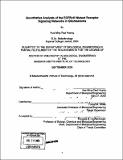Quantitative analysis of the EGFRvIII mutant receptor signaling networks in Glioblastoma
Author(s)
Huang, Hua Ming Paul
DownloadFull printable version (29.08Mb)
Alternative title
Quantitative analysis of the Epidermal Growth Factor Receptor-vIII mutant receptor signaling networks in GBM
Other Contributors
Massachusetts Institute of Technology. Biological Engineering Division.
Advisor
Forest M. White.
Terms of use
Metadata
Show full item recordAbstract
Glioblastoma multiforme (GBM) is the most aggressive adult brain tumor and remains incurable despite multimodal intensive treatment regimens. EGFRvIII is a truncated extracellular mutant of the EGF receptor (EGFR) that is commonly found in GBMs and confers tumorigenic behavior. Although much work has been done over the past decade to elucidate pathways involved in EGFRvIII receptor signaling, the global map of the signaling networks that it activates remains incomplete, making it difficult to assess downstream components involved in EGFRvill-mediated transformation. To gain a molecular understanding of the mechanisms by which EGFRvIII acts, we have employed a mass spectrometry-based phosphoproteomic approach to quantitatively map cellular signaling events activated by this receptor. Using this approach, we have determined the major downstream pathways activated as a function of titrated EGFRvIII receptor levels. This analysis highlighted several aspects of EGFRvIII tumor biology, including crosstalk between EGFRvIII and other receptor tyrosine kinases. Specifically, we have identified the c-Met receptor as a co-target in the treatment of EGFRvIII positive GBM cells, and have shown that an EGFR and c-Met combination inhibitor strategy may be applicable in overcoming the poor efficacy of EGFR kinase inhibitor monotherapy in GBM patients. We then went on to investigate the mechanisms by which signaling networks are regulated in response to site-specific tyrosine mutations on EGFRvIII. This analysis has revealed a receptor compensation mechanism that is capable of restoring network architecture, upon the loss of a major tyrosine phosphorylation site on EGFRvIII. (cont.) This is, to our knowledge, the first demonstration of signal compensation at the level of receptor phosphorylation and highlights an unexpected level of complexity within the signaling network. Our data also indicates that EGFRvIII fine-tunes the activity of the Erk pathway; some Erk activity is required for growth but excessive pathway activation results in cell death. We believe that the sensitivity to modulation of the Erk pathway may be exploited as a potential means of therapy for EGFRvIII positive tumors. Taken together, our study highlights the utility of quantitative phosphoproteomic analysis as a tool to gain molecular insights in cancer biology and a means for drug target discovery.
Description
Thesis (Ph. D.)--Massachusetts Institute of Technology, Biological Engineering Division, 2008. "September 2008." Includes bibliographical references and index.
Date issued
2008Department
Massachusetts Institute of Technology. Department of Biological EngineeringPublisher
Massachusetts Institute of Technology
Keywords
Biological Engineering Division.